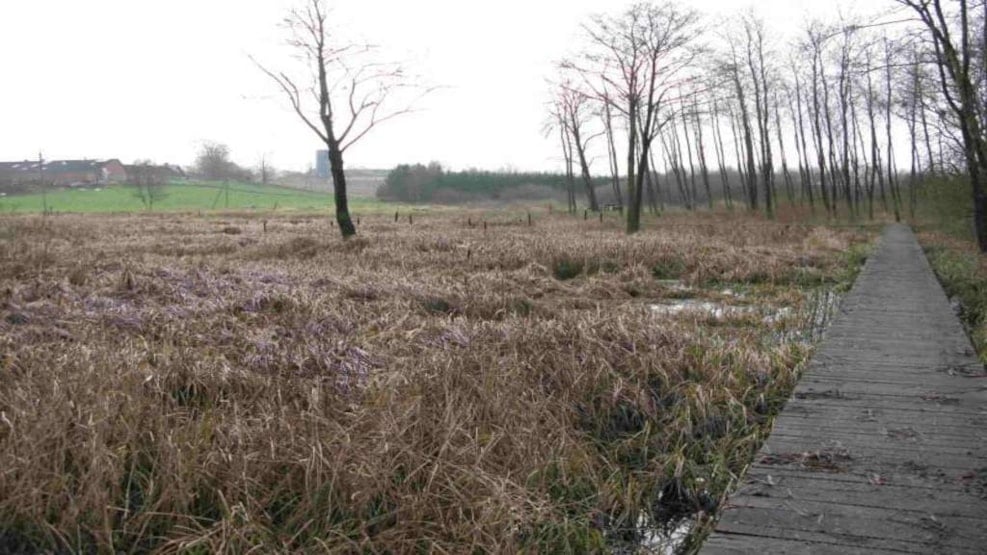
Boringholm medieval castle ruins
By Boring Lake, near Rask Mill, lie the ruins of an unusual castle construction from the 14th century. The castle was built in the middle of a lake – and made entirely of wood. Today, the castle is long gone and there is not much left to be seen, but you can access the mound in the middle of the lake by a wooden bridge from the mainland.
The remains of a unique castle ruin by the Gudenå River
Near the village of Boring, close to Rask Mill, you find Boring Lake (also known as Rask Mill Lake). Today, the lake is drained and appears as marshland, surrounded by forests, meadows, and cultivated areas – but back in the Middle Ages, it was a larger, more shallow lake. In 1368, a large wooden fortress was built on a mound, right in the middle of the lake.
Before the fortress could be built, the mound had to be expanded. This was done by adding soil to more than 2000 buried piles. The castle itself was surrounded by a bulwark and sheet pilings, and to reach the castle, you had to cross one of two bridges, each up to 50 meters long. Its primary defence was the surrounding swamp.
The castle tripled its size in 1380, consisting of four half-timbered buildings, with the main building being four-winged.
A castle from chaotic times
The choice to put Boringholm in the middle of a lake, tells us about the importance of security at this time, building it in such an inaccessible place.
The 14th century was a particularly chaotic and tumultuous time in Denmark – and it was during this period, in which the castle was built, that it was at its very worst. At the end of Valdemar IV Atterdag's reign, the nobility of Jutland forged an attack on the king, leading to civil war-like conditions throughout the country. It has yet to be discovered whether Boringholm belonged to supporters of the king – or enemies. What we do know, is that the castle belonged to Margrethe I in 1406, and it was probably around this time, following its relatively short lifespan, that the castle was abandoned and burned.
This part of the Gudenå River, east of Tørring, was notoriously inaccessible in ancient times with its bogs and marshes. Precisely for that reason, it provided excellent conditions for securing yourself with a fortification here – and there exist remains of several castles in the Gudenå area from this time.
In the turbulent Danish society of this time, everyone had to defend themselves as danger also manifested itself through lootings. There was a bridge to Boringholm from the village of Boring, and it is not unlikely that the villagers moved here when faced with serious threats. With the expansion of Boringholm in 1380, the castle took on a manor-like appearance, indicating a certain level of wealth. Word has it that the castle was replaced by the current manor, Rask.
Who lived on Boringholm?
Boringholm was excavated in the early 1900s, and the findings provided extensive knowledge about life in the castle. A wealth of discoveries was made during the excavation, including swords, shields, and spurs, giving unique insight into the equipment of medieval knights. It illustrates just how much attention the fortress gave to defence.
The bog at Boring Lake has excellent conditions for preservation, which has led to the findings of well-preserved organic materials, such as timber used for building, barrels, tools, and leather shoes. All of these finds from Boringholm hold an important place in Danish medieval research. On castle grounds was also excavated one of Northern Europe's most significant collections of wagon parts from the 14th century. All items are now displayed at the National Museum.
The findings indicate that Boringholm was inhabited by both men, women, and children. Residents belonged to different layers of society, including high-ranking military personnel. Traces of agriculture, cooking, and leisure activities show how they led an ordinary daily life – even in turbulent times of war, life had to go on.
Want to visit Boringholm?
Not many visible traces of Boringholm remain, but you can access the old mound on the lake using a wooden bridge. If you park your car at the small parking lot on Raskvej 52, a path leads into the area about 100 meters west of the parking lot. Right at the entrance to the path, you find an information board about Boringholm.
Boringholm is situated 500 meters from Aale Campsite – and if you are canoeing on the Gudenå River, you have the option of going ashore on the campsite, a few minutes' walk from Boringholm.
Other historical attractions
Kystlandet has many exciting historical attractions to offer, from ancient times to industrial history, from museums to buildings to nature attractions. On this page, you will find inspiration for historically interesting experiences near Horsens, Odder, and Juelsminde.